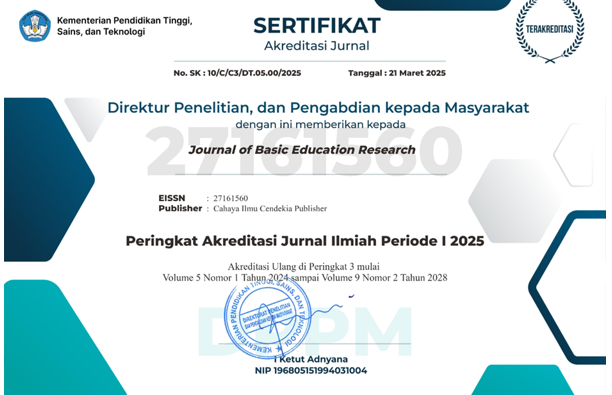Expression of Students’ Elementary School on Planting Lesson
Abstract
Purpose of study: The purpose of this study is to know the students' expressions in carrying out environmental themes by planting trees.
Methodology: This study uses qualitative research. The research approach used a phenomenological research design.
Main finding: Research findings show that elementary school students show positive and negative expressions in the process of planting and maintaining trees.
Novelty/Originality of this study: Learning environmental themes through planting activities has a positive tendency. Students like planting learning activities. Teachers can see learning innovations in environmental themes in this study. So that elementary school teachers can apply similar learning in other primary schools.
References
Liu, Ling, et al. "Food safety assessment of planting patterns of four vegetable-type crops grown in soil contaminated by electronic waste activities." Journal of environmental management vol. 93 no.1, pp 22-30, 2012
Cedamon, Edwin D., et al. "Present tree planting and management activities in four rural communities in Leyte Province, the Philippines." Annals of Tropical Research 27.1 (2005): 19-34.
Hao, Jing-Yi, et al. "Effect of different planting areas on the chemical compositions and hypoglycemic and antioxidant activities of mulberry leaf extracts in Southern China." PloS one 13.6 (2018): e0198072.
Harlow, Ann, and Donella J. Cobb. "Planting the Seed of Teacher Identity: Nurturing Early Growth through a Collaborative Learning Community." Australian Journal of Teacher Education 39.7 (2014): n7.
Agea, Jacob Godfrey, et al. "Attitudes of out-of-school youths towards tree planting activities in Central Uganda: a case study of Masaka District." (2009).
LIAO, Zhengting, and Meijia WANG. "Discussion on Innovative Paths of Primary School Planting Practice Teaching Activities." The Theory and Practice of Innovation and Entrepreneurship 18 (2019): 7.
Allen, Tobias, et al. Tree Planting in Prince George’s County, Maryland: Case Studies and Benefits Assessment in Four Parks. Partnership for Action Learning in Sustainability (PALS), 2019.
Mandujano, María C., et al. "Spatial distribution of three globose cacti in relation to different nurse-plant canopies and bare areas." The Southwestern Naturalist (2002): 162-168.
Curry Jr, Kevin W., et al. "Scientific Basis vs. Contextualized Teaching and Learning: The Effect on the Achievement of Postsecondary Students." Journal of Agricultural Education 53.1 (2012): 57-66.
Chavez, Elpidio. "Inventory of Available Spaces for Planting New Trees in the St. George Campus of the University of Toronto." (2017).
Perlin, Michael L., and Alison J. Lynch. "How teaching about therapeutic jurisprudence can be a tool of social justice, and lead law students to personally and socially rewarding careers: Sexuality and disability as a case example." Nev. LJ 16 (2015): 209.
Nash, Ron. The active classroom: Practical strategies for involving students in the learning process. Corwin Press, 2013.
Carlson, Jake, and Marianne Stowell Bracke. "Planting the seeds for data literacy: Lessons learned from a student-centered education program." (2015).
Cobb, Jeanne. "Planting the seeds… tending the garden… cultivating the student: Early childhood preservice teachers as literacy researchers exploring beliefs about struggling readers and diversity." Journal of Early Childhood Teacher Education 26.4 (2005): 377-393.
Heckman, Paul E. "Planting Seeds: Understanding through Investigation." Educational leadership 51.5 (1994): 36-39.
Parrique, Timothée. "Planting the seed of change: a student-led introduction course to economics." International Journal of Pluralism and Economics Education 6.3 (2015): 219-236.
Nichols, Naomi, David Phipps, and Walter Johnstone. "Planting the seeds for change: a case study from York University’s knowledge mobilization graduate student internship program." Journal of Community Engagement and Scholarship 7.2 (2014): 8.
Gawad, Nada, et al. "Planting the ‘SEAD’: early comprehensive exposure to surgery for medical students." Journal of surgical education 70.4 (2013): 487-494.
Alase, Abayomi. "The Interpretative Phenomenological Analysis (IPA): A Guide to a Good Qualitative Research Approach." International Journal of Education and Literacy Studies 5.2 (2017): 9-19.
Barnard, Alan, Heather McCosker, and Rod Gerber. "Phenomenography: a qualitative research approach for exploring understanding in health care." Qualitative health research 9.2 (1999): 212-226.
Aspers, Patrik. "Empirical phenomenology: A qualitative research approach (The Cologne Seminars)." Indo-pacific journal of phenomenology 9.2 (2009): 1-12.
Paterson, Margo, and Joy Higgs. "Using hermeneutics as a qualitative research approach in professional practice." The Qualitative Report 10.2 (2005): 339-357.
Copyright (c) 2021 Indriyani Ngkoti

This work is licensed under a Creative Commons Attribution-NonCommercial 4.0 International License.
Authors who publish with this journal agree to the following terms:
- Authors retain copyright and acknowledge that the Journal of Basic Education Research is the first publisher licensed under a Creative Commons Attribution 4.0 International License.
- Authors are able to enter into separate, additional contractual arrangements for the non-exclusive distribution of the journal's published version of the work (e.g., post it to an institutional repository or publish it in a book), with an acknowledgment of its initial publication in this journal.
- Authors are permitted and encouraged to post their work online (e.g., in institutional repositories or on their website) prior to and during the submission process, as it can lead to productive exchanges and earlier and greater citation of published work.





.png)


.png)
.png)


















